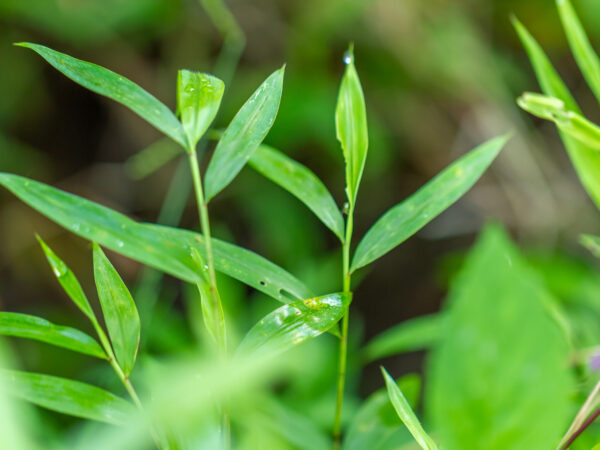PDF version coming soon!

Japanese Stiltgrass (Microstegium vimineum)
Species at a Glance
Japanese Stiltgrass, also known as Nepalese Browntop, or packing grass, is an annual, herbaceous, sprawling grass originating from Asia that has invaded floodplains, streambanks, and moisture rich areas throughout much of the mid-western and eastern United States. It is extremely shade-tolerant and has no native competitors.
Species Description
Resembling a smaller, more delicate version of Golden Bamboo, Japanese Stiltgrass can grow 30-91 cm (1-3 ft) tall in a sprawling, mat-like manner. Its leaves are pale green, narrow, blade-shaped, and alternate on a branched stalk. A distinguishing characteristic is a pale silvery stripe of reflective hairs along the midrib of the top of the leaf. One or two delicate flower spikes grow on top of each stem from late August to September.
Native & Introduced Ranges
Native to China, India, Japan, Korea, and Malaysia, Japanese Stiltgrass was first introduced to Tennessee in 1919, most likely while used as a packing material for porcelain. By 1960, it had naturalized and spread northward to Ohio and Pennsylvania, and eastward to all coastal Atlantic states from Florida to New Jersey. Japanese Stiltgrass can be found throughout Pennsylvania.
Biology & Spread
Japanese Stiltgrass germinates in the spring and grows slowly through the summer months. It spreads mainly through a high production of seeds, with a single plant producing between 10 and 1,000 seeds. These seeds are dispersed by water currents, in materials such as hay, soil, and potted plants, and via foot traffic. Seeds can remain viable in soils for up to five years and emerge from the seedbank when conditions are favorable. It can also spread by sprouting new shoots from stems that come in contact with the ground.
Habitat
While it occurs in a wide variety of habitats and light conditions, Japanese Stiltgrass prefers to colonize disturbed moist areas such as stream banks, recreational trails, floodplain forests, wetlands, fields, roadsides, ditches, utility corridors, and gardens that have been disturbed by mowing, tilling, foot traffic, and flooding.
Impacts
Threat to Biodiversity
Once established, Japanese Stiltgrass rapidly spreads to form extensive mats that displace native plant species. Invasion can also inhibit tree regeneration, survival, and growth; reduce light availability; and impact soil chemistry by changing nutrient cycling processes. Japanese Stiltgrass has little to no value as food for herbaceous grazers like white-tail deer, which increases browse pressure on native vegetation, and provides an opportunity for Japanese Siltgrass to establish and spread in the vacant spaces left behind.
Prevention & Control
Preventing disturbed soils can minimize the chances of a Japanese Stiltgrass infestation. If caught early, small populations can be controlled by hand pulling; ideally in the late summer before seeds set. Populations of Japanese Stiltgrass can also be mowed or the soil tilled while the plants are in flower, but before seed set in late summer to early fall. Mowing or tilling too early will result in the plants still being able to flower and go to seed. Due to the length of time the seeds remain viable in the seed bank, management will be needed for multiple years in combination with site remediation. Larger populations of Japanese Stiltgrass can be managed by using chemical controls both pre-and post-germinations.
References
Barden, L.S. 1987. Invasion of Microstegium vimineum (Poaceae), an Exotic, Annual, Shade-Tolerant, C4 Grass, into a North Carolina Floodplain. The American Midland Naturalist. 118 (1): 40-45.
Corbet, B.F. and Morrison, J. A. 2012. The Allelopathic Potentials of the Non-Native Invasive Plant Microstegium vimineum and the Native Ageratina altissima: Two Dominant Species of the Eastern Forest Herb Layer. Northeast Naturalist, 19 (2): 297-312.
Stahlman, S. 2015. Pennsylvania Field Guide to Aquatic Invasive Species. Pennsylvania Sea Grant. <http://seagrant.psu.edu/topics/aquatic-invasive-species/projects/ais-field-guides>
Whisenhunt, Jeremy. W. 2008. Microstegium vimineum (Japanese stiltgrass) [POACEAE] in Arkansas: Distribution, Ecology, and Competition. University of Arkansas, Masters Thesis.



